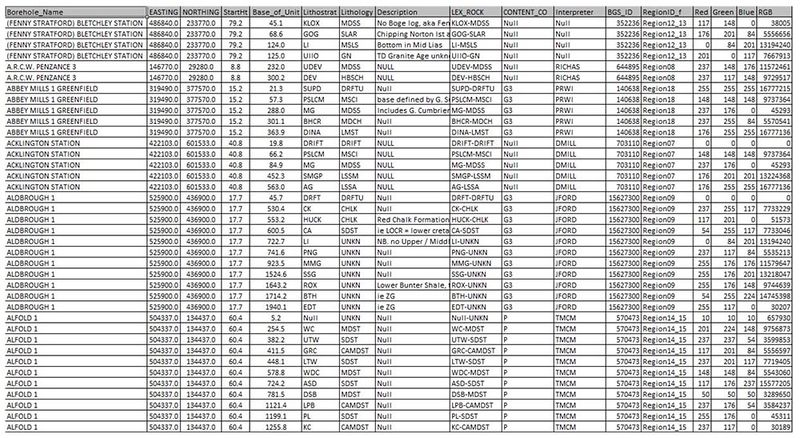OR/14/039 Boreholes
| Mathers, S J, Terrington, R L, Waters, C N, and Thorpe S. 2014. The construction of a bedrock geology model for England and Wales. British Geological Survey Internal Report, OR/14/039. |
The principal aim of this recent phase of GB3D construction (2013–14) was the incorporation of 314 deep boreholes to produce an enhanced model for England and Wales. BGS holds records of several thousand deep (>250 m) boreholes so it was necessary to select a representative subset of these to incorporate into the model.
Quotas were allocated to each regional area based on the region size, geological complexity and in some cases data availability. A selection of non-confidential publicly available boreholes were chosen based on the need to achieve a good distribution of boreholes, utilize the deepest boreholes available, and include boreholes showing well developed rock sequences. Boreholes with published interpretations were given preference.
The initial BGS borehole selection was presented, region by region, to the NDA and their independent peer review panel and agreement was reached on the 314 boreholes to be used (Figure 10, 11) and the revised section alignments (Figure 4).


The distribution of boreholes (Figure 10, 11) nevertheless remains uneven due to the variable data availability. This in turn reflects the regional geology and the presence or absence of economic drivers for the drilling of deep boreholes. So, for example, there are very few deep boreholes in Mid Wales, the Lake District and north Essex where all the available data were used. In contrast several areas contain a wealth of deep borehole data such as Central and Eastern England making the selection of representative boreholes more difficult.
The selected boreholes were classified using the stratigraphic schema of the 1:625 000 scale mapsheets, in many cases existing interpretations were simply accepted and copied across from the internal BGS Stratigraphic Surfaces and Borehole Geology databases. In other cases the boreholes were re-evaluated and a new interpretation was established. A comprehensive MsExcel spreadsheet of the boreholes was produced, giving their BGS Single Onshore Borehole Index (SOBI) name and number, their grid references and start height (Figure 11). This table comprises the GSI3D borehole index *.bid file. The downhole log spreadsheet identifies the units present identified by the BGS Lexicon codes and lithologies following the BGS Rock Classification Scheme, each contains the depth from the start height to the base of the unit. This comprises the GSI3D borehole log *.blg file shown in Figure 12.
Details of the BGS lexicon can be found at: https://www.bgs.ac.uk/lexicon
For the rock classification scheme at: https://www.bgs.ac.uk/bgsrcs/ and the SOBI database at: https://www.bgs.ac.uk/products onshore/sobi.html

